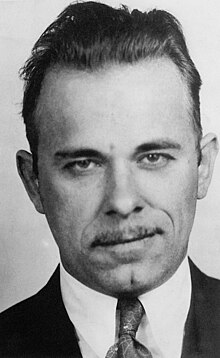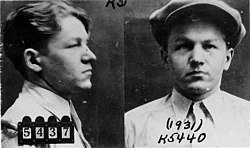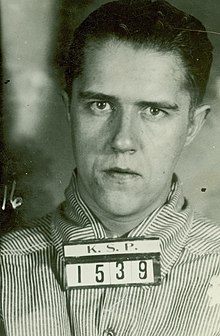That, in turn, made me think of the movie Bonnie & Clyde, and then I got curious about the other colorful outlaws of the 1930s. End result; the rundown you see below. The capture or killing of these criminals is what, along with an astute PR sense, made the FBI and J Edgar Hoover popular icons in America. This summary excludes mobsters like Al Capone, Dutch Schultz, and Legs Diamond, who met their ends in the 30s because the FBI at that time didn't believe the mob existed.
What was surprising to me is that the eight discussed below were taken out of action in a fairly brief period, from September 1933 to May 1936, with six killed within an eight month period in 1934 and 1935. All operated in the heart of America, between the Appalachians and the Rockies. Their memories have been preserved in popular culture with movies (many devoted specifically to their exploits) and songs. Four were officially named as Public Enemy #1 by the FBI (Dillinger, Floyd, Nelson and Karpis).
Machine Gun Kelly

The favorite weapon of George Kelly Barnes (1895-1954) was the Thompson submachine gun, but unlike the rest of the folks on this list, Machine Gun Kelly may never have killed anyone. Kelly was a small time criminal until he met and married Kathryn Thorne after being released from prison in 1928. She convinced him a Tommy gun could become his trademark and she became his virtual publicity agent. They went down for kidnapping Charles Urschel, a wealthy Oklahoma City businessman and holding him for ransom. After his release Urschel provided vital clues to the FBI who eventually tracked Kelly and his wife to a Memphis hotel. Upon breaking into their room on September 26, 1933, Kelly allegedly yelled "Don't shoot, G-Men! Don't shoot, G-Men!", thus providing Hoover's bureau with a catchy nickname. Within three weeks, Kelly and Kathryn were tried, convicted, and sentenced to life imprisonment (justice moved swiftly in those days).
Kelly was a model prisoner at Alcatraz until 1951 when he was transferred to Leavenworth where he died in 1954. Kathryn was released in 1958 and died in the 1980s.
Bonnie & Clyde

Lived fast, died young.
Bonnie Parker (1910-May 23, 1934)
Clyde Barrow (1909 - May 23, 1934)
Both born in Texas, their crime spree covered several states until they were ambushed by law officers led by Texas lawman legend Frank Hamer, who chased them into Louisiana. The FBI was not involved.
Blanche Barrow, Clyde's sister in law, lived until 1988. She didn't like her portrayal in the movie.
John Dillinger
 Like the other folks here, Dillinger was in trouble from a young age. Imprisoned for bank robbery in 1924 he was released on May 10, 1933 and quickly made up for lost time, robbing about twenty banks over the next 14 months. Along the way he was captured and escaped from an Indiana jail. Eventually tracked by the FBI to Chicago, he was betrayed by an informant and gunned down on the street by G-Men after leaving the Biograph Theater on July 22, 1934 after watching Manhattan Melodrama starring Clark Gable, Myrna Loy, and William Powell. It was this event, more than any other, that catapulted the FBI to national renown.
Like the other folks here, Dillinger was in trouble from a young age. Imprisoned for bank robbery in 1924 he was released on May 10, 1933 and quickly made up for lost time, robbing about twenty banks over the next 14 months. Along the way he was captured and escaped from an Indiana jail. Eventually tracked by the FBI to Chicago, he was betrayed by an informant and gunned down on the street by G-Men after leaving the Biograph Theater on July 22, 1934 after watching Manhattan Melodrama starring Clark Gable, Myrna Loy, and William Powell. It was this event, more than any other, that catapulted the FBI to national renown.Pretty Boy Floyd

Pretty Boy Floyd by Woody Guthrie
If you'll gather 'round me, children,
A story I will tell
'Bout Pretty Boy Floyd, an outlaw,
Oklahoma knew him well.
It was in the town of Shawnee,
A Saturday afternoon,
His wife beside him in his wagon
As into town they rode.
There a deputy sheriff approached him
In a manner rather rude,
Vulgar words of anger,
An' his wife she overheard.
Pretty Boy grabbed a log chain,
And the deputy grabbed his gun;
In the fight that followed
He laid that deputy down.
Then he took to the trees and timber
To live a life of shame;
Every crime in Oklahoma
Was added to his name.
But a many a starving farmer
The same old story told
How the outlaw paid their mortgage
And saved their little homes.
Others tell you 'bout a stranger
That come to beg a meal,
Underneath his napkin
Left a thousand dollar bill.
It was in Oklahoma City,
It was on a Christmas Day,
There was a whole car load of groceries
Come with a note to say:
Well you say that I'm an outlaw
You say that I'm a thief.
Here's a Christmas dinner
For the families on relief.Yes, as through this world I've wandered
I've seen lots of funny men;
Some will rob you with a six-gun,
And some with a fountain pen.
And as through your life you travel
Yes, as through your life you roam,
You won't never see an outlaw
Drive a family from their home.
Born in Georgia in 1903, Charles Arthur Floyd's family moved to Oklahoma when he was eight. After serving three years in prison during the 20s he vowed to never again spend time in jail. He didn't. Over the next four years Floyd and his gang robbed plenty of banks and may have been involved in a dozen murders, including those of several police officers.
On October 22, 1934 Pretty Boy was shot in a cornfield near East Liverpool, Ohio. Accounts differ on the specifics of the shooting depending upon whether you believe local law enforcement, the FBI, or residents in the area.
Pretty Boy was not as benevolent as Woody Guthrie made him out to be.
Baby Face Nelson

Like Pretty Boy Floyd, Lester Joseph Gillis did not care for his nickname. That's about the only thing the Coen Brothers got right in their portrayal of Nelson in the movie.
At the age of seven, Chicago born Lester "accidentally" shot a playmate in the jaw with a pistol he found. By the late 1920s, Lester, using the alias George Nelson, led a gang specializing in banks along with home invasions of wealthy businessmen. Baby Face was a stone killer, murdering anyone in his way. In one incident, he was driving with a companion in Minneapolis when another driver cut him off. Baby Face followed him, forced the driver out of his car, and shot him. He killed policemen and is responsible for killing more FBI agents (3) than anyone else. He also collaborated with Dillinger in the months before his death.
Baby Face was killed on November 27, 1934 in a bloody shoot out at Barrington, a suburb of Chicago.
Ma Barker

Ma Barker, born Arizona Dollie Clark in Missouri, was 61 years old when she died on January 16, 1935, along with her son Fred, when the FBI and local lawmen shot up the house they were holed up in at Ocklawaha, Florida. Historians still argue over whether Ma was really the criminal mastermind as portrayed by the FBI, of whether she was just along for the ride with her boys and their friends.
Ma had four sons, Herman, Lloyd, Arthur, and Fred. They were all bad guys. Herman, the oldest, served time for a robbery in which he ran over a child with his getaway car. He died in a 1927 robbery in which he killed a police officer and then shot himself when cornered. By the following year Lloyd was imprisoned in Leavenworth, Arthur in Kansas State Prison, and Fred in Oklahoma State Prison.
In 1931, Fred was released and he and Ma joined up with Alvin Karpis to form the Karpis-Barker gang (son Arthur also joined upon his release in 1932), and they all merrily embarked on the usual robbery spree. Things ended when on January 8, 1935 Arthur was captured in Chicago and on him were letters revealing Ma and Fred's location in Florida. Ten days later, federal agents poured hundreds of rounds into the Ocklawaha hideout.
Arthur ended up in Alcatraz where he was killed in a 1939 escape attempt. Released from Leavenworth in 1938, Lloyd was in the army during the Second World War serving as a cook at a prisoner of war camp in Michigan! Lloyd was finally fully rehabilitated in 1949 when he was murdered by his wife. And that's the end of the Barkers.
Alvin "Creepy" Karpis
 Albin Francis Karpavicius was the last of these miscreants to go down. Raised in Topeka, Kansas, Alvin was a criminal by the age of ten. In 1926, at the age of 19 he was sentenced to the State Reformatory in Kansas from which he escaped. Caught for stealing a car he was sent to the Kansas State Penitentiary where he met Fred Barker. Upon their release they formed the Barker-Karpis gang with many considering Alvin the real brains behind the operation (though we are, of course, speaking relatively when it comes to brains and this gang). With the Barkers, and on his own, he pulled off a string of bank robberies, kidnapping, and even a train robbery, while killing without compunction.
Albin Francis Karpavicius was the last of these miscreants to go down. Raised in Topeka, Kansas, Alvin was a criminal by the age of ten. In 1926, at the age of 19 he was sentenced to the State Reformatory in Kansas from which he escaped. Caught for stealing a car he was sent to the Kansas State Penitentiary where he met Fred Barker. Upon their release they formed the Barker-Karpis gang with many considering Alvin the real brains behind the operation (though we are, of course, speaking relatively when it comes to brains and this gang). With the Barkers, and on his own, he pulled off a string of bank robberies, kidnapping, and even a train robbery, while killing without compunction.Karpis narrowly escaped the Ocklawaha shoot out having left three days before. He spent the next year on the run before being captured in New Orleans on May 1, 1936. Sentenced to life imprisonment he was sent to Alcatraz where he was held until the prison closed in 1962. He spent more time on The Rock than any other prisoner. After Alcatraz closed he was transferred to Federal prison in Michigan before being paroled in 1969 and deported to Canada (where he was born). Karpis moved to Spain in 1973 and died there in 1979.
No comments:
Post a Comment